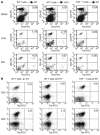The H1 histamine receptor regulates allergic lung responses
- PMID: 16680192
- PMCID: PMC1448167
- DOI: 10.1172/JCI26150
The H1 histamine receptor regulates allergic lung responses
Abstract
Histamine, signaling via the type 1 receptor (H1R), has been shown to suppress Th2 cytokine production by in vitro cultured T cells. We examined the role of H1R in allergic inflammation in vivo using a murine asthma model. Allergen-stimulated splenic T cells from sensitized H1R-/- mice exhibited enhanced Th2 cytokine production. Despite this Th2 bias, allergen-challenged H1R-/- mice exhibited diminished lung Th2 cytokine mRNA levels, airway inflammation, goblet cell metaplasia, and airway hyperresponsiveness (AHR). Restoration of pulmonary Th2 cytokines in H1R-/- mice by intranasal IL-4 or IL-13 restored inflammatory lung responses and AHR. Further investigation revealed that histamine acts as a T cell chemotactic factor and defective T cell trafficking was responsible for the absence of lung inflammation. Cultured T cells migrated in response to histamine in vitro, but this was ablated by blockade of H1R but not H2R. In vivo, allergen-specific WT but not H1R-/- CD4+ T cells were recruited to the lungs of naive recipients following inhaled allergen challenge. H1R-/- T cells failed to confer airway inflammation or AHR observed after transfer of WT T cells. Our data establish a role for histamine and H1R in promoting the migration of Th2 cells into sites of allergen exposure.
Figures






References
-
- Corrigan C.J., Kay A.B. CD4 T-lymphocyte activation in acute severe asthma. Relationship to disease severity and atopic status. Am. Rev. Respir. Dis. 1990;141:970–977. - PubMed
-
- Robinson D.S., et al. Predominant TH2-like bronchoalveolar T-lymphocyte population in atopic asthma. N. Engl. J. Med. 1992;326:298–304. - PubMed
-
- Robinson D., et al. Activation of CD4+ T cells, increased TH2-type cytokine mRNA expression, and eosinophil recruitment in bronchoalveolar lavage after allergen inhalation challenge in patients with atopic asthma. J. Allergy Clin. Immunol. 1993;92:313–324. - PubMed
-
- Finkelman F.D., et al. IL-4 is required to generate and sustain in vivo IgE responses. J. Immunol. 1988;141:2335–2341. - PubMed
Publication types
MeSH terms
Substances
Grants and funding
LinkOut - more resources
Full Text Sources
Molecular Biology Databases
Research Materials

